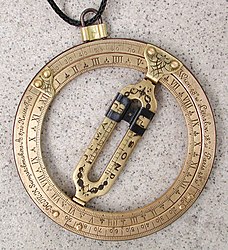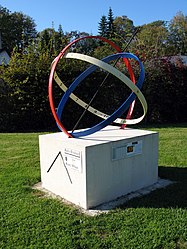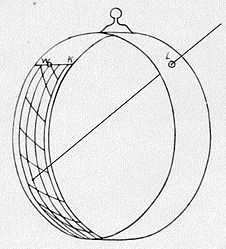Ring sundial
The term ring sundial is used several times:
- Usually the portable ring sundial is in the form of a ring-shaped equatorial sundial , but with an adjustable mode instead of a pole rod .
- A ring-shaped equatorial sundial with a scale on a ring instead of a plane is also called a ring sundial for short .
- The peasant ring is also sometimes referred to as a simple ring sundial . There are peasant rings that are only the size of a finger ring, which can be another reason to call it a ring sundial.
The portable ring sundial

The portable ring sundial resembles a stationary ring-shaped equatorial sundial when it is opened. It has the shape of an armillary sphere reduced to two rings . In contrast to the equatorial sundial, it has a nodus instead of a pole rod and functions as an altitude sundial . This is set on the polar axis depending on the declination of the sun (date of the year) and is usually shaped like a hole.
Working principle
The function as an elevation sundial does not mean the height of the sun above the horizon , as is usually the case , but its elevation angle above the celestial equator . This angle is identical to the sun's declination angle, which practically does not change over the course of the day. The equatorial scale ring represents the celestial equator, the correctly set nodus the sun. In order for the sunbeam to fall on the equatorial ring, it must be rotated together with the ring sundial around the vertical axis. The beam falls on the mark that indicates the time of day. At the same time, the sundial is “north-north” and could be fixed as a stationary equatorial sundial. The outer ring is in the plane of the celestial meridian .
Since there are two ways in which the light spot falls on the scale ring, apart from at true noon, you have to know whether it is morning or afternoon. The quickest way to use the clock correctly is to ensure that the light spot falls to the right in the morning (looking at the clock so that you look down from above along the backdrop) and to the left in the afternoon. At lunchtime, the spot of light hits the scale ring only in a dragging manner. The measurement accuracy is now lowest: error about ± 5 minutes. At True Noon itself, no reading is possible due to the shadows cast by the outer ring. On the equinoxes there is no light spot because the scale ring casts shadows.
use
- The geographical latitude of the place of use is set on the outer ring by moving the hanging loop to the corresponding latitude value.
- The hole slide is set to the date of the year in the slide rod.
- The freely hanging sundial is rotated horizontally until the sunlight falls through the hole onto the line on the inner surface of the inner ring (scale ring) (note whether it is morning or afternoon). The link rod can be rotated around its axis so that a full light spot can always be provided.
- The true local time is read off the hour scale at the light spot.
Web links
- Modern portable ring sundial with additional maps of the earth
- Pictures of ring sundials (advertisement)
Individual evidence
- ↑ Helmut Sonderegger: Bauernringe , Deutsche Gesellschaft für Chronometrie, annual publication 2006, pp. 165–74
- ↑ a b Jörg Meyer: The sundial and its theory . Verlag Harry Deutsch, 2008, ISBN 978-3-8171-1824-3 , page 354.


